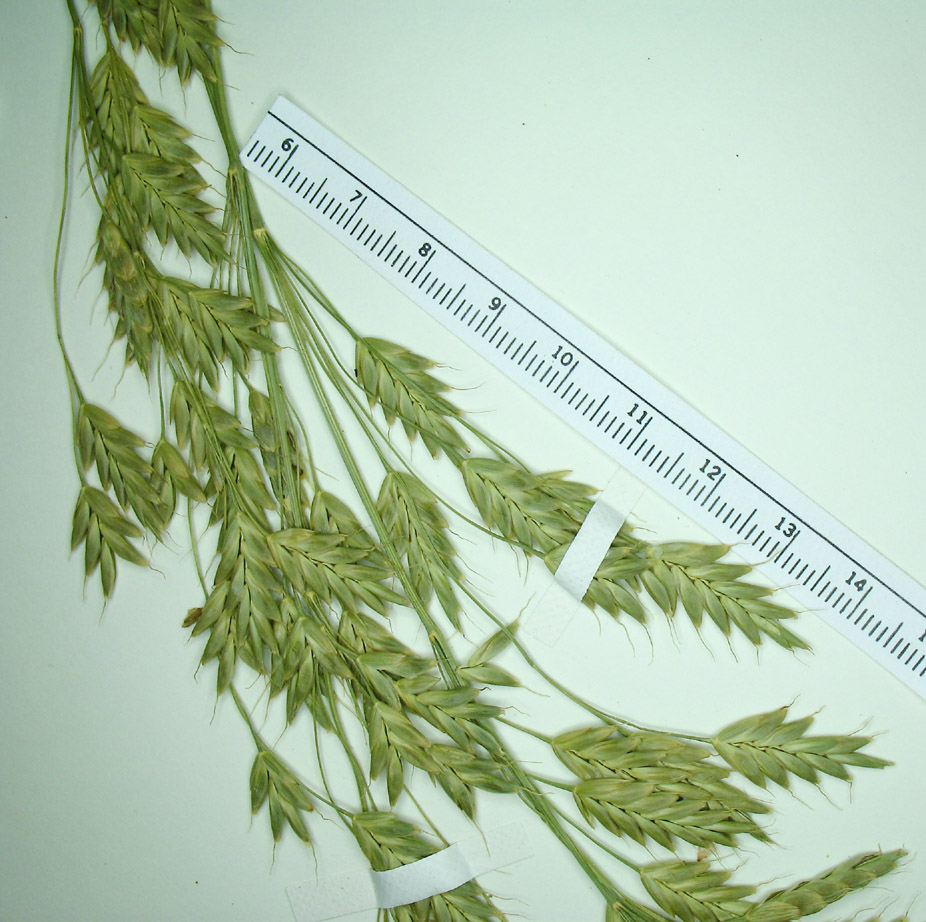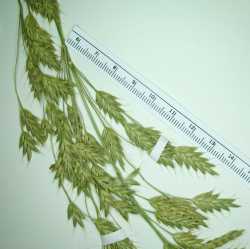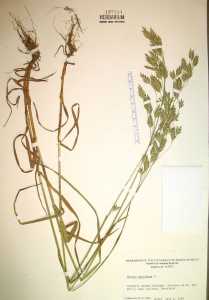Frequent to common in all parts of the state. It is found almost everywhere in cleared grounds except in pastures. It is most abundant in wheatfields and waste grounds. In Indiana it is called cheat.
Common Name: rye brome
Duration: Annual
Nativity: Non-Native
Lifeform: Graminoid
General: Introduced annual to 1 meter tall with a spreading inflorescence that droops at maturiity, containing glumes that appear similar to rye grain.
Vegetative: Leaf blades 15-30 cm long, 2-4 mm wide, pilose to glabrous; stems 20-30 cm tall, erect, mostly hidden by sheaths, lower sheaths glabrous or pubescent,; ligules 2-3 mm long.
Inflorescence: Panicles open, drooping at maturity, 5-23 cm long, 2-12 cm wide; branches spreading to ascending, in whorls of 3-5 near base; spikelets 1-2 cm long glabrous to sparsely minutely pubescent, laterally compressed; glumes mostly elliptical, glabrous; glumes unequal, lower glumes 4-6 mm with 3-5 veins, upper glumes 6-7 mm with 7 veins; lemmas 6-9 mm long, 1-2 mm wide, faintly 7-veined, rounded, usually glabrous along backs; awns 3-6 mm, straight; anthers 1-2 mm.
Ecology: Found in fields, disturbed open areas, and along roadsides at elevations up to 5000 ft. (1500 m); flowers May-July.
Distribution: Found throughout the United States.
Notes: An aggressive grass, preferring sunny, disturbed areas. Is native to Europe. Bromus secalinus var. velutinus is differentiated by having pubescent spikelets.
Ethnobotany: Unknown
Etymology: Bromus comes from Greek bromo for stinking, while secalinus means resembling rye.
Editor: LKearsley 2012
Annual 3-12 dm; culms glabrous or sometimes retrorse-hairy below the nodes; middle and upper sheaths generally glabrous, the lower glabrous or hairy; blades 3-8 mm wide, glabrous or hairy; ligule 0.5-3 mm; infl loose and open, 7-15 cm, its branches several from a node, simple or again branched; spikelets 1-2.5 cm, usually drooping, 6-12-fld; first glume oblong, 4-6 mm, 3- or 5-veined, the second similar, 5-8 mm, 5- or 7-veined; lemmas elliptic, obtuse, 6-9 mm, obscurely 7- veined, glabrous or minutely scaberulous, rarely evidently hairy, awnless or with an awn to 6 mm between the two broad teeth; margins of the lemma soon involute, causing the florets to diverge and expose the flexuous rachilla; palea about as long as the lemma; anthers 1-2 mm; 2n=14, 28. Native of Europe, where often a weed in wheat-fields; intr. in grain-fields, roadsides, and waste places throughout the U.S.
Gleason, Henry A. & Cronquist, Arthur J. 1991. Manual of vascular plants of northeastern United States and adjacent Canada. lxxv + 910 pp.
©The New York Botanical Garden. All rights reserved. Used by permission.















